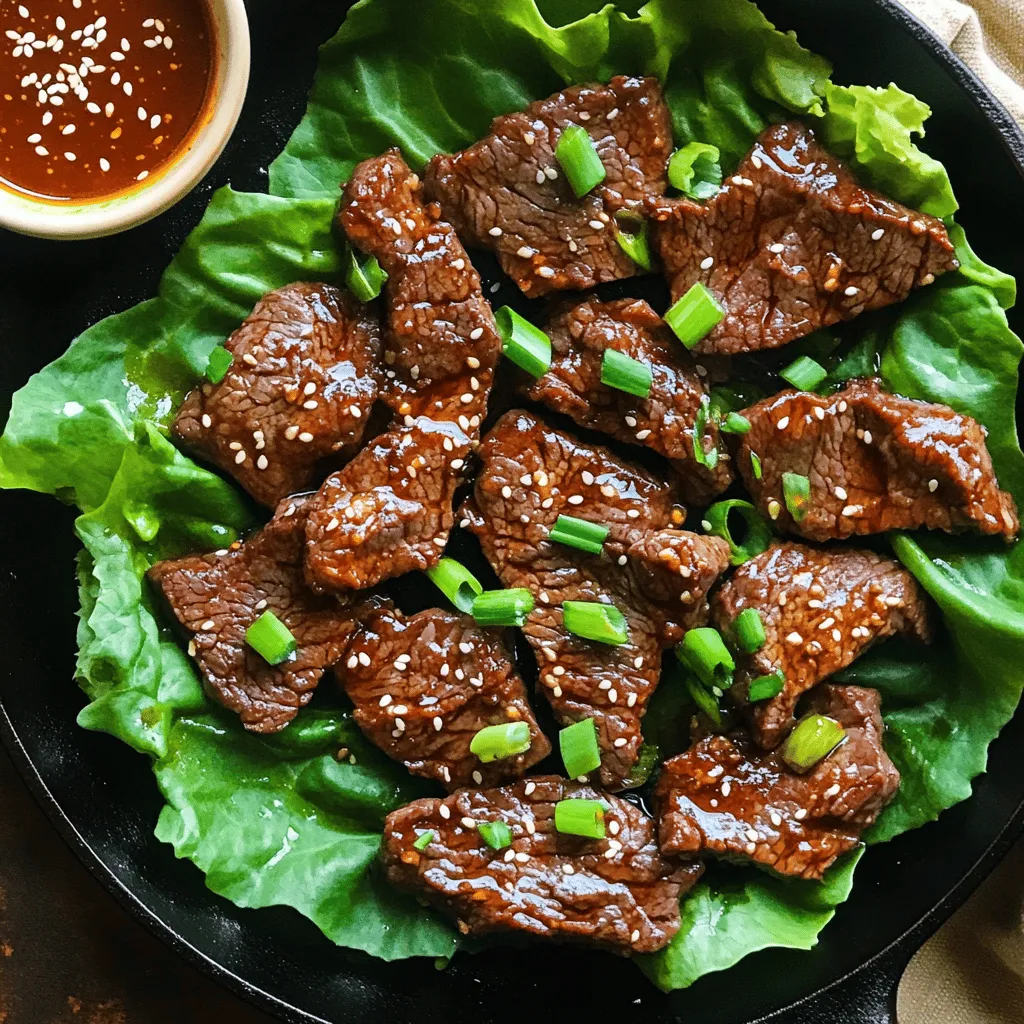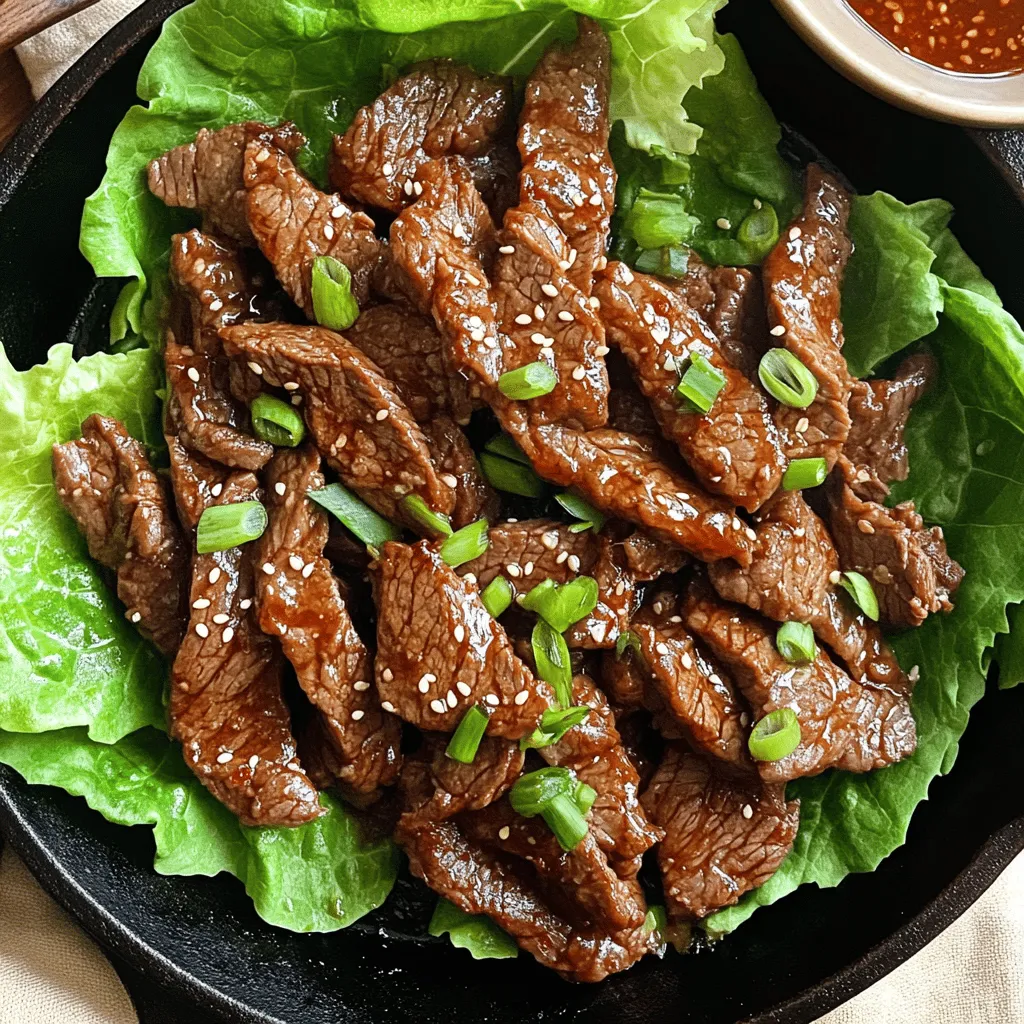Are you ready to spice up your dinner routine? This Spicy Korean Beef Bulgogi recipe is not only tasty but also easy to make! With just a few simple ingredients, you can create a flavorful meal that impresses everyone. Whether you’re a kitchen novice or a seasoned chef, you’ll enjoy each step of this delicious dish. Let’s dive into the flavors of Korea and get cooking!
Ingredients
Main Ingredients
- 1 lb thinly sliced beef sirloin
- ¼ cup soy sauce
- 2 tablespoons brown sugar
- 1 tablespoon sesame oil
- 1 tablespoon gochujang
Additional Flavorings
- 1 tablespoon minced garlic
- 1 tablespoon minced ginger
- 1 teaspoon black pepper
- 1 tablespoon sesame seeds
- 3 green onions, chopped
Cooking Essentials
- 1 tablespoon vegetable oil (for cooking)
- Lettuce leaves (for serving)
In this recipe, I use thinly sliced beef sirloin for a tender bite. The soy sauce adds saltiness, while brown sugar gives a touch of sweetness. Sesame oil brings a nutty flavor, and gochujang gives that spicy kick.
Next, I add minced garlic and ginger for depth. Black pepper enhances the taste, while sesame seeds and green onions add crunch and color.
Lastly, I use vegetable oil for cooking. I serve the bulgogi wrapped in fresh lettuce leaves. This keeps it fun and fresh!
Step-by-Step Instructions
Preparing the Marinade
Start by mixing the marinade. In a bowl, combine:
- ¼ cup soy sauce
- 2 tablespoons brown sugar
- 1 tablespoon sesame oil
- 1 tablespoon gochujang
- 1 tablespoon minced garlic
- 1 tablespoon minced ginger
- 1 teaspoon black pepper
Stir these ingredients until they blend well. This mixture gives your beef great flavor.
Marinating the Beef
Next, add the beef. Toss in 1 lb of thinly sliced beef sirloin. Make sure each piece gets coated in the marinade. Cover the bowl with plastic wrap. Let it sit for at least 30 minutes. You can marinate it overnight for even more flavor.
Cooking the Beef
Now, it’s time to cook. Heat 1 tablespoon of vegetable oil in a large skillet over medium-high heat. Once the oil is hot, lay the marinated beef in a single layer. Sear each side for 2-3 minutes. You want it cooked through and a little caramelized.
When it’s done, sprinkle sesame seeds and chopped green onions on top. Give it a quick stir before serving. Enjoy your Spicy Korean Beef Bulgogi wrapped in lettuce leaves!
Tips & Tricks
Achieving the Right Spiciness
To get the perfect heat in your bulgogi, adjust the amount of gochujang. Start with one tablespoon. If you want more spice, add chopped chili peppers. These bring extra flavor and heat to your dish. Always taste as you go. This way, you can find the right balance.
Perfecting the Texture
High heat is key for great bulgogi. Use a large skillet or grill pan. Heat it well before adding the beef. This helps to caramelize the meat. Sear each side for 2-3 minutes. This gives the beef a nice crust while keeping it juicy inside. Don’t overcrowd the pan. Cook in batches if needed.
Serving Suggestions
Serving bulgogi is fun and simple. Use fresh lettuce leaves as wraps. Place a spoonful of bulgogi inside each leaf. Add a side of rice for a complete meal. For extra flavor, serve with a small bowl of gochujang for dipping. Garnish with sesame seeds and green onions for color and crunch. Enjoy!

Variations
Alternative Meats
You can swap the beef for chicken, pork, or tofu. Each option brings a unique taste.
- Chicken: Use thinly sliced chicken breast. It cooks quickly and absorbs flavors well.
- Pork: Thin pork loin is a great choice. It adds a slightly sweet flavor.
- Tofu: For a plant-based option, use firm tofu. Press it to remove excess moisture first.
Vegan Bulgogi
For a vegan twist, replace beef with mushrooms, eggplant, or zucchini. These provide great texture and flavor.
- Mushrooms: Shiitake or portobello mushrooms work best. They add umami and depth.
- Eggplant: Slice it thinly and marinate just like beef. It soaks up the sauce well.
- Zucchini: Use thin strips for a fresh taste. It cooks quickly and adds moisture.
Spice Level Adjustments
You can control the spiciness based on your taste. Start with less gochujang for a milder dish.
- Mild: Use just a teaspoon of gochujang. Add more soy sauce for balance.
- Medium: Stick to the original recipe for a nice kick.
- Extra Spicy: Increase gochujang or add chopped chili peppers. Adjust to your heat level.
These variations let you enjoy Spicy Korean Beef Bulgogi in many ways!
Storage Info
Refrigeration Guidelines
Store any leftover bulgogi in an airtight container. It stays fresh in the fridge for up to 3 days. This way, you can enjoy it again soon. Just remember to let it cool before sealing.
Freezing Instructions
If you want to save some for later, freeze the marinated beef before cooking. Wrap it tightly and keep it in the freezer for up to 2 months. When you’re ready, thaw it overnight in the fridge. This keeps the flavors intact and makes for a quick meal.
Reheating Tips
To reheat, use a skillet over medium heat. This keeps the beef juicy. You can also use the microwave, but do it in short intervals. Stir the beef to heat evenly. This way, you will enjoy the taste just like fresh.
FAQs
What is the origin of Bulgogi?
Bulgogi has deep roots in Korean history. It dates back over 600 years. Bulgogi means “fire meat” in Korean. The dish started as a noble feast food. Today, it is loved by all. People enjoy it at home and in restaurants. The dish represents Korean culture and hospitality. It shows how food can bring people together.
Can I make Bulgogi without gochujang?
Yes, you can! If you don’t have gochujang, try using sriracha. Combine it with soy sauce and a bit of sugar. Another option is chili powder mixed with soy sauce. These will give you heat and flavor. You may lose some depth, but it will still taste good.
What can I serve with Bulgogi?
Bulgogi pairs well with many sides. Here are some ideas:
- Steamed rice
- Kimchi
- Pickled vegetables
- Sautéed spinach
- Cucumber salad
- Lettuce leaves for wraps
Wrap the beef in lettuce for a tasty bite. Enjoy the meal with friends and family!
Bulgogi offers a tasty and easy dish to enjoy. We covered essential ingredients, easy steps, and tips for perfecting your meal. You can also explore variations, from meatless options to spice adjustments. Remember to store your leftovers properly for future enjoyment. Whether you stick to the classic recipe or make it your own, bulgogi brings flavor and fun to your table. Now, get cooking and savor each bite of this Korean delight!


